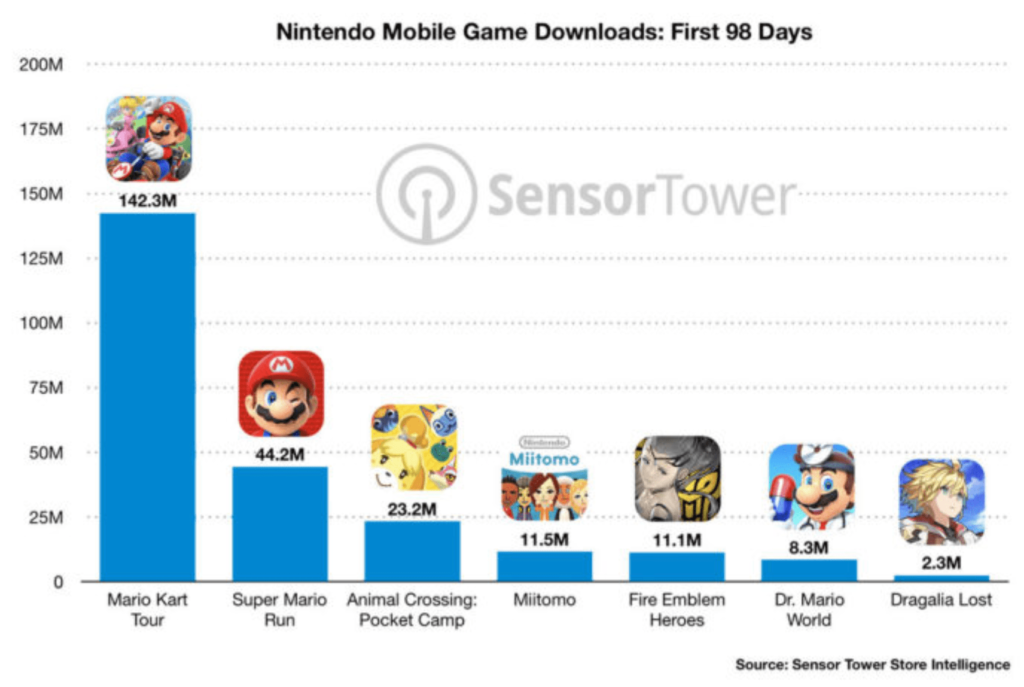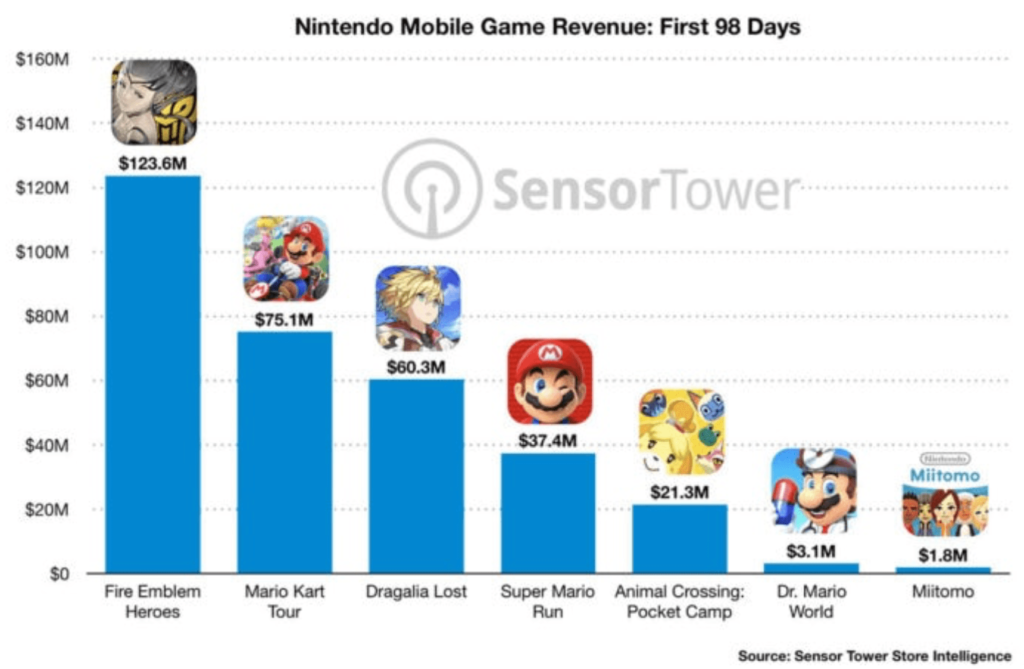If you follow our blog, you know there are two topics we never miss a chance to cover: mobile gaming monetization techniques and Nintendo’s mobile game releases. Now that Mario Kart Tour has been out for a few months, this seems like a good opportunity to evaluate how the game is performing. Let’s dig into the gameplay itself, the monetization approach, the financial performance, and the audience reception.
The Gameplay
First of all, let’s touch on the gameplay. Power sliding and mini turbos are such a critical part of the modern Mario Kart experience, and I was really skeptical of how Mario Kart Tour could implement this mechanic. It turns out they really did a great job with this! The manual control scheme retains the familiar left-to-right toggling throughout a turn to manage your drift. Some of the other mechanics are simplified. Your driver automatically accelerates forward. There are no brakes or reverse. The game even employs some automatic assistance to redirect your driver back on the course. Ultimately, these are all reasonable compromises for the limitations of the mobile interface to ensure that the mini turbo and drifting mechanics all feel as tight as possible. It works quite nicely!
There’s a pretty nice flow of new content as well. Nintendo releases some new courses and characters every two weeks. There are new challenges and a ranking tournament each week. The multiplayer is still in beta, but that’s something to look forward to. The game is still relatively new, so I suspect Nintendo had a lot of these new courses and characters stockpiled to gradually release. Nevertheless, hopefully they can keep up this pace of content release.
The Monetization Approach
Mario Kart Tour uses the now quite familiar gacha mechanic to get new characters, karts, and gliders. If you’re not familiar with gacha, check out this old post where we discussed the technique. Essentially, you’re using in-game currency, in this case rubies, to pay for a chance to pull a random character, kart, or glider out of a pipe. This is the only way to get most characters, karts, and gliders, but you can also acquire a limited set of the roster with gold (the less rare in-game currency). Collecting duplicates makes an item stronger. Oddly enough, you don’t even get to play with Mario to start the game, unless you pull him from the pipe or buy him in the store with gold!
Nintendo’s two revenue streams are selling rubies and offering a monthly Gold Pass subscription for $5.00. The Gold Pass offers more challenges every two weeks, a faster speed class, plus it gives you a bunch of rubies, gold, characters, and such. Compared to buying rubies directly in the store, it’s a terrific deal. Or perhaps viewed another way, the rubies in the store seem quite expensive. There are always a couple special bundles going on to buy a character plus some rubies, with a not so rare character in a $20 bundle, and a rarer one in a $40 bundle. Even with the added kicker, rubies are still fairly expensive. For what it’s worth, I’m a Gold Pass subscriber, but I haven’t made any other purchases.
Subscriptions have become increasingly common in mobile games in the last few months. While the freemium mindset has traditionally been to focus on whales that are going to spend hundreds or possibly thousands of dollars, there’s a growing stigma against this practice, at least in some circles. The subscriptions are relatively cheap. Mario Kart Tour’s $5.00 per month price translates to $60.00 per year, which is about the price of a console game. That sounds reasonable to a lot of consumers, including myself, who don’t usually buy consumable in-app purchases. Subscriptions also charge the consumer indefinitely until they unsubscribe, so there’s a nice stickiness to the revenue stream. Overall, it seems like a smart approach.
The Financial Performance
Sensor Tower compiled the downloads for the first 98 days after release of Nintendo’s mobile titles.
As you can see, Mario Kart Tour is the clear winner. The game generated more than 3 times as many downloads as Super Mario Run, the second most downloaded Nintendo game for the opening 98 days. In fact, Mario Kart Tour was the most downloaded game in the App Store for all of 2019, even though it came out toward the end of the year. There’s no questioning the broad appeal and reputation for quality that the Mario Kart franchise has built up over the last couple decades.
Revenue is also good, but not as dominant. This time, Mario Kart Tour comes in second, earning about 60% as much as Fire Emblem Heroes. The fact that Fire Emblem can outpace Mario Kart on revenue despite having less than 10% as many users is truly a testament to how well Fire Emblem’s revenue model works.
We’ve touched on Fire Emblem’s financial performance in the past while analyzing Dr Mario World, but let’s discuss why it differs so much from Mario Kart Tour. First, we know gacha games perform better in Japan than in the US. There is less stigma against spending money on mobile games in Japan, so relatively niche titles that target a Japanese user base can outperform franchises with broader global appeal. Second, Mario Kart appeals to a wider range of ages, including many children who don’t have money to spend on games. That’s going to drive revenue per user down. Lastly, RPGs lend themselves to gacha mechanics better than racing games. RPG players are used to leveling things up, which is a critical part of the gacha experience. You can continue to layer in new complexities to the game so the player base always has something to chase. This keeps gamers occupied (and spending money) for years. Mario Kart has traditionally catered to a more casual audience. Sure, you can pull for new drivers and level them up, but it remains to be seen whether Nintendo can add enough complexity to the game to keep players hooked for the long-term.
The Audience Reception
Mario Kart Tour currently has a 4.8 in the App Store and a 4.2 on Google Play, so it’s safe to say that most players are happy with it. I will say the online community sure does complain a lot though (see Reddit). On the one hand, I think this has to do with Mario Kart’s broad appeal. A lot of Mario Kart fans who would not normally play gacha games are playing Mario Kart Tour, and they don’t like the gacha mechanics.
There’s more to it than that though. Mario Kart Tour puts a tremendous amount of emphasis on the weekly ranking tournament. That’s my main focus in the game. This puts you in direct competition with other users. This is different from other successful gacha titles, such as Puzzle and Dragons, where the focus is mostly on the single player experience (Player vs Environment instead of Player vs Player, to use the industry jargon). Consequently, whales are generally celebrated on the Puzzle and Dragons subreddit for their crazy team builds and financial support of the game. The Mario Kart Tour subreddit is mostly filled with hate toward whales for paying to win the ranking tournaments.
The tournament emphasis puts Nintendo in a tricky spot. They don’t want to make the game too pay-to-win, but they also need to make sure their paying customers see value in what they’re buying. This whole matter is complicated by the fact that the game actually does have quite a bit of skill. Maintaining a combo over an entire course is very difficult in some levels, and only doable by the top players. Nonetheless, many weaker players seem to think they only lose because they’re being outspent, which frustrates stronger players, and generally makes for a contentious community.
Conclusion
Mario Kart Tour is off to a reasonably strong start. The downloads are tremendous. The financial performance is quite good, though not as strong per user as the top Japanese gacha titles. That’s to be expected though. It will be interesting to see how the revenue develops from here.
The community health doesn’t seem wonderful for the long-term viability of the game, but that can be fixed. When Puzzle and Dragons does ranking dungeons, sometimes they use fixed teams. This way players can’t complain about pay-to-win mechanics. It’s all about skill (and some luck). Mario Kart Tour might be well off to do the same thing from time to time for its ranking tournaments. That would be enough to silence grumblings from the weaker players and show them that they’re not only losing because of pay-to-win mechanics. That would make the stronger players happier. It would also presumably allow the spenders to go about their spending without getting hassled by the community so much. We’ll see if Nintendo follows this route. Either way, they’ve got a hit on their hands! Let’s hope they make the most of it.


